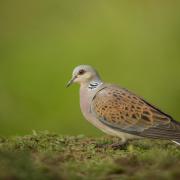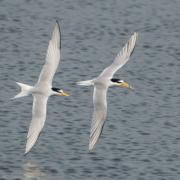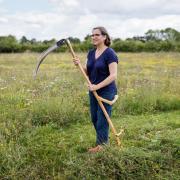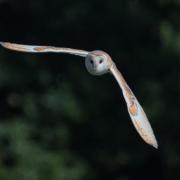Richard Gilbert of the National Trust on managing Dunwich Heath
Heathland heaven
Richard Gilbert, National Trust Warden at Dunwich Heath, shares the secrets of managing the complex mixture of habitats on this beautiful part of the Suffolk coast
Dunwich Heath is a rare remnant of coastal lowland heath where the heather extends right to the cliff top. It is predominantly open heather, but also includes wet and dry woodland and acid grassland. There is a mile of sand and shingle beach and half a mile of soft cliff. The shades of heather contrasted against the yellow gorse in the summer months are enjoyed by thousands of visitors. This spectacle provides a bountiful source of food and shelter for a wealth of wildlife. It also requires a considerable amount of work to maintain.Three types of heather grow here. By far the most common species is Common Heather or ling. It is an evergreen bushy shrub with stalkless leaves growing in distinctive vertical rows. The pinkish purple flowers appear from July to September. The second species, Bell Heather, prefers drier well drained areas. It is a much less bushy plant with leaves arranged in distinctive whorls and has crimson-purple flowers. The third species, Cross-leaved Heath, thrives in wetter areas of the heath. Its leaves are very hairy and it has beautiful rose-pink oval flowers.For the best wildlife habitat, heather should consist of a mosaic of different aged plants. There are four recognised growth phases. The pioneer phase (0 to 6 years) is the period of establishment and growth. Plants reach 10 to 30cm in height and flowering is sparse or absent. The building phase (7 to 15 years produces maximum cover and density of canopy, with luxuriant shoot growth and flowering; plants range from 30 to 60cm. The mature phase (14 to 25 years) starts to see small gaps in the heather canopy with abundant flowering. The final degenerate phase (25 years plus) sees a much more open canopy as the central branches die back, allowing other plant species to grow. Each phase benefits wildlife in different ways, whether it’s birds, invertebrates or reptiles.To manage heather, we divide all 68 hectares into a number of compartments. Compartments can range from 1 to 8 hectares in size. Each year, during the autumn and winter months, we cut a small proportion of the compartments using a tractor and flail. We generally cut the older, degenerate heather. After flailing, we remove the heather cuttings and strip the top layer of soil in each cut area with a tractor and front-loader. The aim is to encourage the heather to grow back from the underlying seed-bank.For a number of years our neighbours the RSPB have assisted with the task of removing the heather cuttings. In return for their efforts we donate some of this heather material to the RSPB for their arable reversion project, where they are trying to re-create heather heathland.The areas of bare ground left from this clearance heat up in the sun, and are great for insects, birds and reptiles. In addition, on other areas of the heath we have created sandy banks which are very popular with mining bees and digger wasps, some species of which are nationally notable. And where insects flourish, birds can find good feeding too.The large, robust European Gorse grows beside the roads and paths. It prefers disturbed ground and is rarely found on the open heath. Although it can flower all year round it peaks between March and May. Later in the summer the more unusual Western Gorse comes into flower. It is a much more compact and bushy plant which grows amongst the open heather. Gorse is home to thousands of invertebrates, and is thus a very important feeding habitat for one of our iconic species, the Dartford Warbler. Dartford Warblers stay all year round, so need this thick gorse and heather to feed and roost during the long winter months. Other birds to see on the heath include stonechat, woodlark, nightingale, green woodpecker, linnet, hobby and nightjar. You can also often hear the bitterns “booming” from neighbouring Minsmere, and see marsh harriers perform spectacular aerial displays.A wide range of reptiles live on Dunwich Heath, including adder, slow-worm, grass snake and common lizard. These creatures require a variety of habitats: heather, bracken and grass to hide and hunt in, and sunny sandy banks and other bare areas to bask on. They also hibernate within south facing slopes and embankments.If the heath wasn’t carefully managed it would soon begin to revert to woodland, so part of my work includes cutting invasive species such as bracken and birch. However you may notice that we retain some areas of bracken as well as birch trees of various sizes around the heath. Birch is good for insects and also provides excellent perches for birds, thus adding structure to the heathland. Bracken on the lower slopes provides excellent cover for snakes and lizards.We couldn’t do what we do here vv without our volunteers. We have our own team of Dunwich Heath volunteers. They have recently planted 350m of new hedge at our nearby property, Mount Pleasant farm, thus completing the existing hedge planted in 2006. The hedge consists of hawthorn, field maple, hazel and blackthorn and will provide an excellent habitat for insects, birds and mammals. Another big project completed thanks to our volunteers is the selective clearance of vegetation along an area of water known as Docwra’s Ditch, which abuts the south-western boundary. The ditch was created in 1970, originally as a source of water in case of heathland fire. If left un-managed it would eventually become choked with vegetation and scrub.Last year we cleared small sections of vegetation along the ditch. This sort of clearance is part of standard rotational ditch management, creating different phases of succession to benefit different species. Fortunately early this year we secured funding from a charitable trust to improve freshwater wetlands. With the money, we were able to employ a highly skilled digger driver, Trevor, to ‘slub’ the areas of the ditch we had cleared of overgrown vegetation. Slubbing is the removal of silt and built up detritus from the base of the watercourse. This leaves the areas looking bare, but it’s not long before reeds, sweet grass, rush and sedge start to flourish. The open areas created are excellent for invertebrates, especially dragonflies. In the last few weeks I have seen large red damselfly, hairy dragonfly, blue tailed and azure damselfly and four-spotted chaser.In addition we slubbed a pond used by school groups for pond-dipping. The children regularly find newts, diving beetles, dragonfly larvae, water boatmen, frogs, water scorpion, leeches, mayfly and stonefly nymphs among their catches. It’s essential to have a species monitoring programme in place to measure the success of our nature conservation. This is yet another area where our volunteers are invaluable.Clive Moore has been monitoring the reptile population on Dunwich Heath and Mount Pleasant Farm for the last four years. Working with another volunteer Dave Brougham, Clive also runs a ‘moth trap’. This is basically a metal box filled with egg boxes. A mercury vapour lamp secured on the top attracts moths, which then settle in the egg boxes inside the trap. The best conditions are on warm, overcast and windless nights. Dunwich is an excellent habitat for moths, being near to reed beds, dunes and the coast, all of which are ideal for a variety of species. Some of the moths found here are reliant on heather heath, such as common heath, true-lovers knot, emperor and narrow-winged pug. Dave also helps with the common bird census, a survey to record the breeding birds, as well as undertaking regular butterfly and dragonfly surveys. We also have another volunteer, Sandy, whose special interest is plants. The monitoring undertaken by Clive, Dave, Sandy and myself means we have records for a variety of species. There is one insect on the heath which particularly fascinates me – the Ant Lion. It is a nationally rare species that up until the early 1990s was thought to be extinct in Britain. It requires a very precise type of habitat to thrive, and is generally confined to areas in the Suffolk Sandlings. It needs warm sandy banks with overhanging vegetation as well as mature pine trees nearby.The adult Ant Lion looks superficially like a dragonfly, but as they are mainly nocturnal you are unlikely to see them. However, the conical pits that are constructed under sandy banks by the larvae are quite noticeable as they are often in large groups of several hundred or more. The larvae bury themselves next to these pits and wait patiently for unwary insects and spiders to fall in. Should an insect attempt to climb out, the larvae, using its head, will flick grains of sand at it. The larvae grab their prey with their powerful jaws and then suck them dry – gruesome! The pits vary in size reflecting their different ages as the larvae take at least two years to reach adulthood.In late summer, usually around dusk when the adults are ready to emerge, they climb out of the pit, grabbing on overhanging vegetation to assist them. Once emerged, like dragonflies they must wait till their wings harden. Then the males and females congregate under mature pines, where males compete with each other to attract females.The mated females then search for suitable nesting areas to lay their eggs. Unfortunately when attempting to lay eggs in the sandy banks, they often fall victim to their own larvae!There many more insect species here with equally strange lives. Solitary bees and wasps nest in bare ground, short grass, banks and soft cliffs. Although it’s quite a specialised area, I’d like to find out more to understand the real breadth of nature which thrives here at Dunwich Heath.I’m in the process of developing new interpretation to help visitors discover which particular species you can see, and where, on any given day. We run regular Walks with the Warden if you’d like a more guided visit. We are always happy to answer questions too if you see us when you visit!
- Visit www.nationaltrust.org.uk/dunwichheath for more information about Dunwich Heath and events including Walks with the Warden.


























